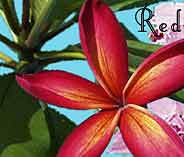 |
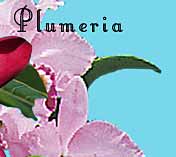 |
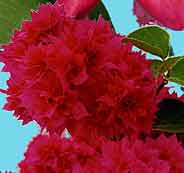 |
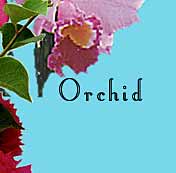 |
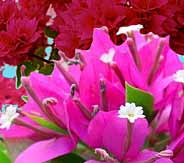 |
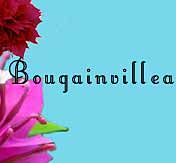 |
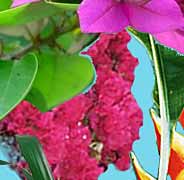 |
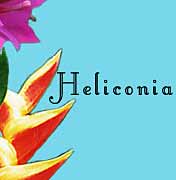 |
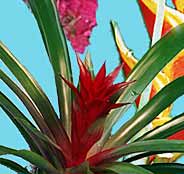 |
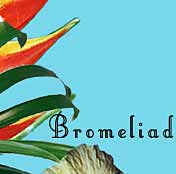 |
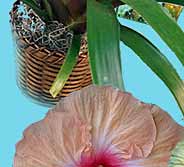 |
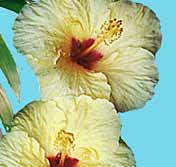 |
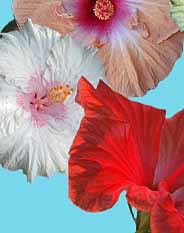 |
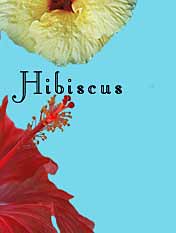 |
more Absolutely Florida
related story: Florida's Citrus

A State Blooming with Gorgeous Flowers
by Dru Murray
 |
 |
 |
 |
 |
 |
 |
 |
 |
 |
 |
 |
 |
 |

![]() lorida
is gorgeous. Many would say that is due to its water. A peninsula, the Atlantic
surrounds it on one side and the Gulf on the other. Indeed, much of the land
itself is punctured by water in the form of the Everglades, rivers, creeks,
lakes, springs, and canals.
lorida
is gorgeous. Many would say that is due to its water. A peninsula, the Atlantic
surrounds it on one side and the Gulf on the other. Indeed, much of the land
itself is punctured by water in the form of the Everglades, rivers, creeks,
lakes, springs, and canals.
True, the waters of and around Florida are to some responsible for its beauty. But beauty is, as they say, in the eye of the beholder. And in this beholder's eyes, the real beauty of Florida is in its flora. Apparently, the flowers of Florida were what first met the eyes of the Spanish explorer who claimed the area for Spain in 1513. Ponce de Leon named the region "Florida," which means "full of flowers" in Spanish.
Excepting Hawaii, Florida is the most southernmost state in the country and home to no less than three climate zones (9, 10 & 11). Though the northernmost climate zone can see freezing temperatures during the winter, the southernmost part is subtropical.Only three other states enjoy such balmy climates at all: Texas, Louisiana, California, and of course, Hawaii.
For the length of the state, from the northwestern panhandle to the southern tip where Key West hangs on, Florida's beauteous flowers and plants are world renowned. And the variety is tremendous.
![]()
Amazingly, Florida is home to one-half of all the tree species contained in
the entire United States. Forests cover nearly two-thirds of the state and
include slash pine,
bay,
black tupelo,
magnolia,
oak,
and sweetgum.
Ash,
beech, hickory,
maple,
red cypress,
and yellow pine
(loblolly and long-leaf) flourish. Dogwood,
magnolia,
and redbud
prosper in the north, while the more watery south supports numerous mangroves
in ubiquitous swamps. The state tree is the sabal
palm.
Of course, the citrus crop of Florida is legendary. Florida orange juice is consumed worldwide. The citrus fruit industry became big business in the 1890s when Lue Gim Gong, a Chinese horticulturist living in De Land, introduced a new variety of orange and a hardier grapefruit. Today, oranges comprise Florida's leading cash crop and the orange blossom is the state flower.
![]()
Florida's wildflowers are no less diverse. The list is long -- irises,
lilies,
lupines,
orchids,
and sunflowers.
Other flowers happily residing here include azaleas,
camellias,
gardenias,
hibiscus,
oleanders,
and poinsettias.
Climbing vines such as the Carolina yellow
jasmine, Cherokee
rose, morning
glory, and trumpet
creeper grow everywhere, while the
flame vine, or golden
bignonia, and the orange,
purple, magenta, and white blossoms
of bougainvillea
grace many garden walls in the southern part of the state.
The subtropical area, which includes Miami and the Keys, is home to astoundingly interesting plants. Among them are myriad palms; banyans, absolutely huge trees that drop roots in strange haunting dangles to the ground; and flowering trees, the likes of which this author had never seen until arriving in Florida. Even "bushes" in Miami are amazing, with the rare and endangered cycads shooting fern-like leaves reminescent of dinosaur days direct from rough brown low-to-the-ground trunks. Some of this lushness often forces Floridians to struggle to rid their yards of excess growth. Often, giant piles of defunct palm fronds, cocoanuts, and brush lay resolutely waiting for garbage pickup.
Savoring
one of his tasty homegrown Praying Hands bananas, Joe Harris smiles.
"Our gardens have not only introduced us to a world of magnificent
plants but also a world of magnificent people."
Visit the Kona Kai Resort's website.
Rare and exotic fruits -- lychees,
sapotes,
figs,
guavas,
pineapples,
cherimoyas,
papayas,
lemons,
limes,
grapefruits,
and the beloved mangoes
-- are avidly grown by both commercial and residential enthusiasts in Miami.
Smooth-skinned avocadoes
the size of softballs may be plucked fresh as they dangle languidly from their
mother branches.
Designed and planted by the owners, Joe and Ronnie Harris, the gardens
at Kona Kai in Key Largo are fashioned to evoke feelings of a tropical
paradise with hints of native Keys, Everglades and tropical rainforest
plantings. The gardens are planted in a somewhat random and untamed
manner so one can enjoy them as if walking through a tropical forest
rather than a formal garden.
The gardens include many native plantings, over 42 different species
of palms and cycads including many rare, endangered or hard to find
species; 26 tropical and subtropical fruit trees including 9 different
varieties of bananas; over 40 different varieties of bromeliads; more
than a dozen hybrid hibiscus, each producing magnificent rare blooms;
a collection of over 225 orchids; and countless other trees and landscape
plants.
"Visiting Fairchild Gardens and the Homestead Fruit and Spice Park
was our original inspiration for Kona Kai's gardens. Touring the nurseries
of Homestead, the Redlands and other areas of South Florida has become
our source for many of these plantings," says Joe Harris, the innkeeper
at this charming, exclusive resort in Key Largo.
What
grows there:
Breadfruit and Jackfruit
trees, Seashore Palm,
Wallich's Palm, Cuban
Petticoat Palm, Cuban
Belly Palm, Biccario
Phoenix Madagasearian
Palm, Old Man Palm,
Dutchman's Pipe and
Praying Hands bananas.
Keys natives include:
Firebush, Gumbo Limbo,
Mahogany, Coontie, Plumbago,
Silver Buttonwood, Green
Buttonwood, Jamaican Caper,
Lignum Vitae, Golden Dewdrop,
Necklace Pod, Buccaneer Palm,
Silver Key's Thatch Palm,
Seagrape, Spanish Stopper,
Poisonwood, Joewood, Natal
Plum, and Florida Thatch Palm.
Contributions from friends and Kona Kai guests include: bromeliads from
the president of the local Bromeliad Society, a flame ginger from Hawaii,
a green Ti plant, a White Ginger from a private greenhouse in Northern
California, an Asian Shell ginger from a local botanist, 3 rare-to-Florida
Plumeria's from southern California; a rare Black Guava tree from a
prominent tropical fruit tree cultivator and many, many orchids (which
make the perfect gift for anyone!).
pictured:
a banana pod, photographed by Joe Harris
![]()
Spring brings the bounty of the flowering trees in Miami. They paint a rainbow
canopy over streets and yards. Orange, pink, white, red, purple - all the
colors of the rainbow are displayed on high by profuse flowering trees. The
sun-yellow flowers of Tabebuia
caraiba greet the day as tiny
trumpets, while their relative, Tabebuia
rosea, presents lovely pink
tiny trumpet flowers - mostly pink with a spot of yellow on the interior.
The orchid tree, Bauhinia
purpurea, is decked out with
gorgeous medium-purple orchid-like flowers. Bristly bright red flowers, often
up to six inches in length, hang profusely from Bottlebrush
trees, a temptation for many birds. It is not uncommon to see green wild parrots
loudly diving down to partake of their succulent nectar. Another stunner is
the shaving brush tree, Pseudobombax
ellipiticum. Its precious pink
flowers are reminescent of oldtime shaving brushes. Purple blossoms adorn
jacaranda
trees and crepe myrtles
bless the yards they are in. Plumeria
proudly display their dainty blooms, both white and pastel; their flowers
are the ones used to form the "beads" of the famed leis of Hawaii.
But the queen of all the flowering trees is the Royal
Poinciana. She displays her wondrous
chunks of brilliant reddish-orange or yellow flowers and then blanket yards
with colorful carpets. Later, long wooden pods hang off the trees. Called "Flameadors"
in Puerto Rico, Royal Poincianas are the territory's tree. The Royal Poinciana
Festival is held annually in the spring.
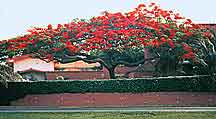
![]()
Everglades National Park
4000l State Road 9336
Homestead, FL 33034
305-242-7700
No study of Florida flora could ignore the Everglades. The Everglades National
Park is truly unique among American vistas as it is the only subtropical wilderness
in the U.S. Designated as a national park in 1947, it received a Wilderness
Designation in1978, and became a Wetland of International Importance in1987.
Water, water is everywhere as fresh, brackish, or sea waters cover its 1.5 million acres. A stunning panorama of sawgrass gently swept by the winds is broken only by sporadic hammocks, little islands propping up outcrops of tropical hardwoods or pines. Appropriately called The River of Grass, the Everglades, or Glades as they are affectionately called by Floridians, are home to not only a great variety of flora, but also the accompanying fauna. Endangered, rare, and exotic species call the Glades home. Interestingly, it is the only place in the world where alligators and crocodiles coexist. Click for more about the Everglades. Rich bird life, particularly large wading birds such as the roseate spoonbill, wood stork, great blue heron, and a variety of egrets inhabit the park. For more about Florida's birds, click here.
Popular among visitors is a waterborne closeup look at all the interesting inhabitants, both plant and animal. Kayak and canoe campers, along with birders, hikers, anglers, and plenty of car-bound curiosity-seekers descend upon the park when the temperatures and mosquitoes subside. The best time to venture into the Glades is during the winter and early spring, November through mid-March. For more information about the park, visit www.nps.gov/ever.
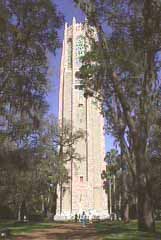
The Bok Carillon Tower.
Bok Tower Gardens
1151 Tower Boulevard
Lake Wales, Florida 33853-3412
863-676-1408
The centerpiece of this gorgeous garden is a huge bell tower, or 57-bell carillon.
Inscribed in its pink and gray marble and coquina stone from St. Augustine
are carvings depicting Florida's flora and fauna. Recitals are heard daily
with clock music emanating from the tower every half hour beginning at 10
a.m. Founder Edward Bok built the gardens in an effort to preserve the highest
hill of Florida's central ridge. And preserve it he did. The site is a refuge
for some 20-30 endangered plant species and over 100 varieties of birds. For
more information, visit the web site at www.boktower.org.
Busch Gardens
10000 McKinley Drive
Tampa, Florida
813-987-5171/813-987-5082 (recorded
info)
In its 355 acres, Busch Gardens presents Africa, with a myriad of animals
and tropical plants. The lovely gardens may be viewed by riding on the monorail,
taking the Skyride, or climbing aboard a train. One area, called Myombe Reserve,
replicates the tropical homeland of gorillas and chimpanzees, complete with
waterfalls and piped-in tropical fog. Bird Gardens contains exotic birds and
birds of prey in a lush walk-through aviary, plus a three-story treehouse.
For more information, click here.
Fairchild Tropical Garden
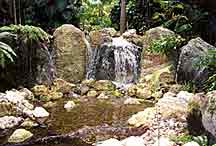
10901 Old Cutler Road
Coral Gables (Miami), Florida 33156
The largest tropical garden in the United States, Fairchild Tropical Garden
offers visitors 83 acres of lush greenery and gorgeous flowers interspersed
with lakes, streams, grottos, and waterfalls. Named after David Fairchild, an
intrepid explorer who traveled the world over to learn about and gather rare
plant species, Fairchild is home to palms, cycads, bamboo, heliconias, and hibiscus.
Fairchild offers visitors a broad range of experience, from sweeping vistas
to close, dense foliage. Also a research center, the garden provides easy-to-follow
self-guided walking tours of the Montgomery Palmetum, McLamore Arboretum, Native
Plants, or the new Rainforest are offered mid-November through April. The Rainforest
is an exciting new exhibition that provides a tropical rainforest experience,
one that fills the senses. A rainforest has plentiful water, understory plants
such as heliconias and palms, and in the all-important canopy, numerous epiphytes,
plants that grow on other ones. Most orchids are epiphytes. Plus, here you can
taste tropical cuisines and unusual fruits. To obtain more information about
Fairchild, visit the web site at www.ftg.org.
The Kampong
4013 Douglas Road
Coconut Grove, Florida 33133
305-445-8076
The Kampong is the second National Tropical Botanical Garden in the Miami
area. Coconut Grove, is a treasure of flowering trees and tropical fruit cultivars
on a gentle slope that extends to the sea and also is the site of David Fairchild's
former modernistic home. Visitors must call ahead to schedule a time to visit
this stunning garden. For more information, visit www.ntbg.org/kampong.html.
Parrot Jungle

11000 SW 57th Ave.
Miami, FL 33156
305-666-7834
Touted mainly for its wildlife, most
notably its brilliantly colored parrots and cockatoos, Parrot Jungle also has
a rich, lush gardens that include shrimp plants, bromeliads, bamboo, cypress,
and live oak trees. Currently located in Pinecrest, the Miami institution will
soon be moving to Watson Island near Miami Beach. For more info, visit the web
site at www.parrotjungle.com.
The Gifford Aboretum
Department of Biology
University of Miami
Coral Gables, FL 33124
305-284-3973
For a look at the myriad trees that are native to Florida and beyond, you
can stop by the Gifford Aboretum. There you can view trees with names ranging
from the Snuffbox Tree,
to Mahogany,
to the Curly Leaf Guava,
and the Torch Tree.
The Fruit & Spice Park
24801 SW 187th Ave.
Homestead, FL 33031
305-247-5727
The Fruit & Spice Park is located amidst the Redlands in South Dade County.
Besides numerous classes, lectures, events, and tours, it offers 100 varieties
of citrus fruits, 50 of bananas, and 40 of grapes, plus all kinds of exotics.
The Redlands itself is home to many nurseries, including ones entirely dedicated
to the production of orchids. Indeed, at least one of those nurseries produces
no less than one million orchids per year.
The Miami Beach Botanical Garden
2000 Convention Center Drive
Miami Beach, Florida 33139
305-673-PALM or 305-673-4166
Discover The Miami Beach Botanical Garden, a recently refurbished lush 4 1/2-acre
tropical garden. Miami Beach's secret garden, though it lies in one of the world's
most popular playgrounds, it provides a wonderful retreat. The horticultural
focus has been on a children's vegetable garden, a Japanese Garden, and a newly
conceived preview garden. The Miami Beach Conservancy staff is dedicated
to renovating the Miami Beach Botanical Garden to make it a world-class facility.
Currently, the conservancy is working to implement its vision for the future
with the creation of Garden 2000. This new subtropical garden will offer 7,000
square feet of plants, water features, pathways, and lighting. The Preview Garden
will be a focal point for upcoming garden events, as well as be an ideal spot
for a stroll or simple relaxation.
Author Dru J. Murray is the editor of TropicalGardening.com and resides in Miami, Fla. A biologist and avid gardener, she is totally in love with Florida's flora.